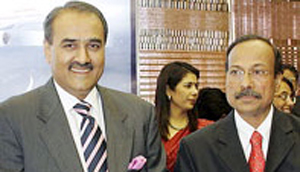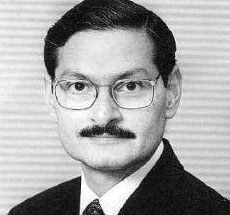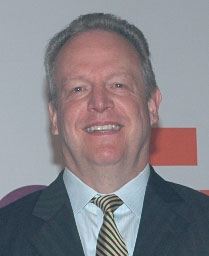India
Roundup As Kerala Opens
Indian Civil Aviation Minister Praful Patel and Kerala Chief Minister
V. S. Achuthanandan along with the state's ministers and dignitaries pose
for a group photograph during the foundation stone laying ceremony of
Kannur International airport.
As 2011 begins, the aviation and logistics
community of India is taking off.
Now three years down the line, Kerala, India’s
southern state, will see its fourth international airport.
The Kerala Chief Minister, V. S. Achuthanandan,
laid the foundation stone for the fourth international airport of the
State at Kannur recently.
The airport, which is to be commissioned
by 2013, will cater to one-third of the two million-strong Kerala workers
in the Gulf and trigger the fast-phased economic development of the northernmost
part of the state.
Along with the Chief Minister of the state
was India’s Civil Aviation Minister, Praful Patel.
In his address, Patel said that the Kerala’s
air connectivity would get a boost with the Kannur airport. Kerala launched
the country’s first corporate airport a decade back in Kochi, which
is now the fourth busiest airport in India in terms of international traffic
after Mumbai, Delhi and Chennai.
The state government has a 26 percent stake
in the Kannur International Airport Limited (KIAL) held by the Kerala
Industrial Infrastructure Limited, while 23 percent shares are with the
state and federal public sector enterprises. About 2 percent shares are
with the Infrastructure Kerala Limited (InKEL) promoted by non-resident
Indians, and 48 percent shares are with three Mumbai-based groups, leaving
only one percent for individuals and co-operative societies to subscribe.
“Since 2004, the Indian aviation industry
has grown by 400 percent. Airports are not only about bringing passengers
home. They also bring a lot of economic development and movement of cargo
and that is what we have to create,” Patel said.
 The
KIAL managing director, V. Thulasidas, (pictured right with Civil
Aviation Minister Praful Patel left) a former secretary of aviation
and chairman of Air India, said at 3400 meters the airport would have
the longest runway in the state and a taxi bay along the entire stretch
of the runway. It would be capable of handling aircraft any size available
in the world. The airport, which claims to be the first to be environmentally
friendly in the country, hopes to handle 1.8 million passengers in the
first year of operations and an annual growth of 8 percent is expected
in passenger traffic. Six four-lane roads are also planned for the airport. The
KIAL managing director, V. Thulasidas, (pictured right with Civil
Aviation Minister Praful Patel left) a former secretary of aviation
and chairman of Air India, said at 3400 meters the airport would have
the longest runway in the state and a taxi bay along the entire stretch
of the runway. It would be capable of handling aircraft any size available
in the world. The airport, which claims to be the first to be environmentally
friendly in the country, hopes to handle 1.8 million passengers in the
first year of operations and an annual growth of 8 percent is expected
in passenger traffic. Six four-lane roads are also planned for the airport.
The brains behind the project are the father
and son duo, Captain K. Nair and Vivek Nair of the Leela Group. Over the
years, the group has excelled in the hospitality sector with their top-of-the-line
Leela Hotels.
Logistics Spotlight
India’s logistics industry recently
got a wake-up call: create adequate capacity to meet the rising demand
for multi-modal freight movement or be left behind. With an eye on the
rapid national GDP growth, the logistics industry had to counter the challenges
of infrastructural bottlenecks. G K Vasan, India’s Minister for
Shipping, made this statement at the recent logistics meet that discussed
how to build India’s logistics infrastructure. The other impediment
restricting growth was the high logistics number, which at 13-14 percent
of GDP was way above the level of 7-8 percent of GDP in the developed
countries.
The minister pointed out that the government
has taken a number of measures to support the growth of the logistics
infrastructure, like opening up the industry to 100 percent foreign direct
investment, promotion of a multi-modal transportation network, and public
private partnerships (PPP). Among these initiatives were the National
Highway Development Project, inter-connectivity of the 12 major ports,
enhancement of the port handling capacities, the rail freight corridors
in the east and west and the Dedicated Delhi-Mumbai Corridor.
 Veteran
from the logistics industry, Cyrus Guzder, (left) who is Chairman of the
Confederation of Indian Industry, National Logistics Council, mentioned
that infrastructural bottlenecks and process lags in logistics were costing
the national economy around $50 billion. He also pointed out that the
need was for 20 expressways and not the five or seven that were being
put up. There was also an additional need for 750 new last mile road links
and a considerable number of last mile rail links. Multi-modal logistics
parks would also need to be developed in tandem with the growing demand. Veteran
from the logistics industry, Cyrus Guzder, (left) who is Chairman of the
Confederation of Indian Industry, National Logistics Council, mentioned
that infrastructural bottlenecks and process lags in logistics were costing
the national economy around $50 billion. He also pointed out that the
need was for 20 expressways and not the five or seven that were being
put up. There was also an additional need for 750 new last mile road links
and a considerable number of last mile rail links. Multi-modal logistics
parks would also need to be developed in tandem with the growing demand.
Such demands would not remain unheard. Recently,
Jyotiraditya Scindia, another minister – in fact, the junior minister
in the commerce and industry ministry – enunciated the government’s
keenness to build logistics infrastructure and storage of goods in the
villages. He pointed out that rural India was the most developing and
robust market within the country, which can act as a catalyst for enhancing
the flow of FDI into the country.
The rural economy had a great role in the maintaining the 6.5 percent
growth rate during the global economic recession. If there were a widespread
logistics network in the hinterland, there would be more opportunities
to attract investments from abroad.
K+N Acquires Cool India
 The
Indian wing of Switzerland-based logistics major Kuehne+Nagel (K+N) recently
acquired the Delhi-based RR Enterprises, which had a cold chain logistics
business. Though no figures about the deal were released, it is believed
to be around US$4-5 million. The
Indian wing of Switzerland-based logistics major Kuehne+Nagel (K+N) recently
acquired the Delhi-based RR Enterprises, which had a cold chain logistics
business. Though no figures about the deal were released, it is believed
to be around US$4-5 million.
RRE is not too old. Owner Kapil Bhatia,
a first-generation entrepreneur, had 50 refrigerated trucks and four reefer
containers. His business was all-India and its acquisition by K+N would
help the move to the perishable and cold chain logistics business. Industry
experts believe K+N has seized the opportunity to step into the $475 million
cold chain market in India.
K+N's portfolio is wide: from end-to-end
supply chain management, to sea, air, rail and road freight, contract
logistics and lead logistics. It also does emergency and relief logistics,
fairs and exhibitions and even hotel logistics.
The K+N acquisition is the latest in a long
line of deals in the logistics sector in India. First there was Coffee
Day buying Sical Logistics for $35.38 million, Aqua Logistics taking over
Star Distribution Logistics for $2 million and Hitachi Transport System
Ltd. acquiring Flyjac Transport Logistics System for $56.1 million.
Overnight Deeper Reach
 FedEx
continues to reach out to the furthest corners of India. Recently, it
announced the expansion of its premium domestic express delivery service.
The FedEx Priority Overnight and FedEx Standard Overnight services, which
were launched in October 2009 (reported by ACNFT), will now include 331
destinations, up from 58 destinations previously. This extension of FedEx’s
domestic footprint is intended to support the growth of customers' businesses
by providing increased reach to key Indian markets. FedEx
continues to reach out to the furthest corners of India. Recently, it
announced the expansion of its premium domestic express delivery service.
The FedEx Priority Overnight and FedEx Standard Overnight services, which
were launched in October 2009 (reported by ACNFT), will now include 331
destinations, up from 58 destinations previously. This extension of FedEx’s
domestic footprint is intended to support the growth of customers' businesses
by providing increased reach to key Indian markets.
The expansion highlights the company's focused
growth plan to facilitate unprecedented trade across India through highly
reliable and convenient shipping solutions. The growth builds on the success
of FedEx domestic service offerings since its launch in India and is aimed
at offering customers a one-stop solution for their domestic express needs.
According to Kenneth F. Koval, (leftt) Vice
President, Operations, FedEx Express India, "India's GDP is expected
to grow between 8-9 percent in the FY 2010-2011, making it one of the
fastest-growing economies in the world. Our expansion is designed to facilitate
faster and easier domestic trade and enhance our customers' ability to
leverage the country's growth potential and take advantage of new trade
opportunities."
Tirthankar Ghosh
|




